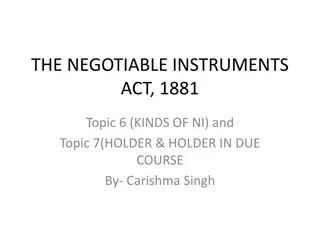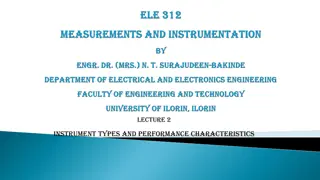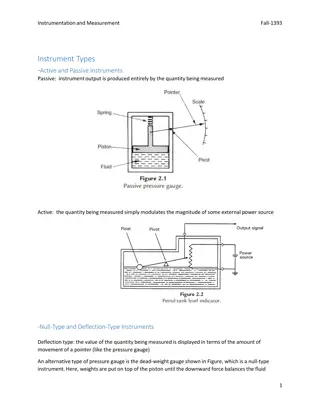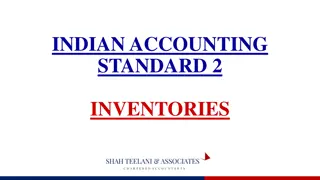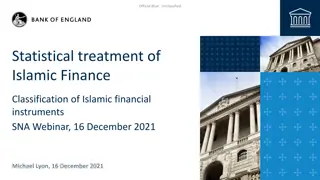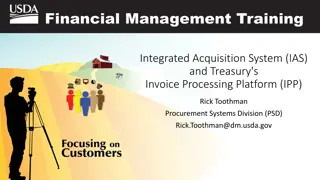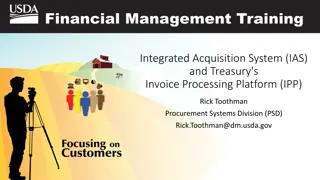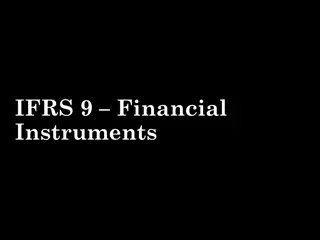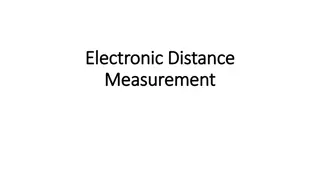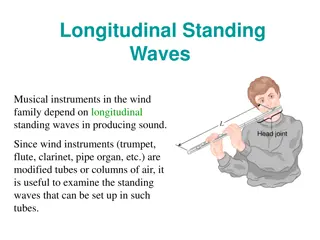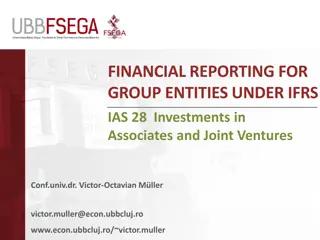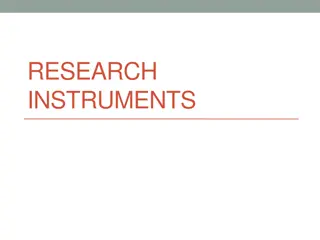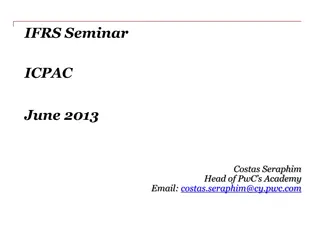Understanding IAS 39: Financial Instruments Recognition and Measurement
This content provides an overview of an IFRS seminar on IAS 39, focusing on key concepts such as the classification and measurement of financial assets, impairment, reclassification, and more. It covers definitions of financial instruments, financial assets, equity instruments, and financial liabilities, as well as classification of financial assets and liabilities into different categories. The session also delves into Financial Assets at Fair Value Through Profit or Loss (FVTPL) and other pertinent topics related to IAS 39.
Download Presentation

Please find below an Image/Link to download the presentation.
The content on the website is provided AS IS for your information and personal use only. It may not be sold, licensed, or shared on other websites without obtaining consent from the author. Download presentation by click this link. If you encounter any issues during the download, it is possible that the publisher has removed the file from their server.
E N D
Presentation Transcript
IFRS Seminar IAS 39 Financial Instruments: Recognition and Measurement
Overview of session Review of key concepts Classification of financial assets Measurement of financial assets Impairment of financial assets Reclassification and tainting Conclusion 2
Review of key concepts A financial instrument is any contract that gives rise to a financial asset of one entity and a financial liability or equity instrument of another entity. An equity instrument is any contract that evidences a residual interest in the assets of another 3
Review of key concepts A financial asset is any asset that is cash, an equity instrument of another entity, a contract that (subject to certain conditions) will or may be settled in the entity s own equity instruments or a contractual right: To receive cash or another financial asset from another entity; or To exchange financial assets or financial liabilities with another entity under conditions that are potentially favourable to the entity. 4
Review of key concepts A financial liability is any liability that is a contract that (subject to certain conditions) will or may be settled in the entity s own equity instruments or a contractual obligation: To deliver cash or another financial asset to another entity; or To exchange financial assets or financial liabilities with another entity under conditions that are potentially unfavourable to the entity 5
Classification Financial assets (Four categories) Financial assets at fair value through profit or loss Loans and receivables Held to maturity Available for sale 6
Classification Financial liabilities (Two categories) Financial liabilities at fair value through profit or loss and Other financial liabilities 7
Classification Financial Assets At Fair Value Through Profit or Loss (FVTPL) At fair value through profit or loss Designated at inception Held for trading Intention of short term profit; Derivatives unless hedges or financial guarantee contracts 3 criteria for designation; Irrevocable 8
Classification Financial Assets At Fair Value Through Profit or Loss (FVTPL) The fair value option Available only if either of the 3 criterion met.These criteria are generally only met by financial institutions and other organisations with sophisticated treasury operations. Criterion 2 Manage as a portfolio on a fair value basis Criterion 1 Accounting mismatch Criterion 3 Embedded derivative 9
Classification - financial assets Loans and receivables Fixed or determinable payments Not quoted in an active market Non- derivative 10
Classification - financial assets Held to maturity Entity has a positive intention and ability to hold to maturity Fixed or determinable payments Non- Fixed maturity derivative There are tainting rules that can stop an entity classifying assets as financial assets held-to-maturity 11
Classification - financial assets Available-for-sale Not classified in any of the other categories Non- derivative 12
Why Is Classification Important? Because it drives subsequent measurement of the financial asset 13
Measurement of financial assets Initial recognition - When (i.e. timing) - How much (i.e amount) - Which account (i.e category) Transaction costs 14
Transaction costs All categories apart from Fair Value Through Profit or Loss include in initial measurement Directly attributable and incremental Fair value through profit or loss - expense 15
Subsequent Measurement Financial assets at fair value through profit or loss At FV through profit or loss Loans and receivables At amortized cost Held to maturity At FV through equity Available for sale 16
Example: Initial fair value An entity enters into a marketing agreement with another organisation. As part of the agreement the entity makes a two year 5,000 interest free loan. Equivalent loans would normally carry an interest rate of 6%, given the borrower s credit rating. The entity made the loan in anticipation of receiving future marketing and product benefits. 17
Example: Initial fair value Solution: The fair value of the loan can be determined by discounting the future cash flows to present value using the prevailing market interest rate for a similar instrument with a similar credit rating. The present value of the cash flow in two years time at 6% is 4,450 ( 5,000 (1/1.062)). On initial recognition of the financial asset the entity should recognise a loss of 550 as follows: DR Loan 4,450 DR Loss (finance expense) 550 CR Cash 5,000 The difference between this initial amount recognised of 4,450 and the final amount received of 5,000 should be treated as interest received and recognised in profit or loss over the two year period. 18
Example: At fair value through profit or loss An entity acquired a derivative on 1 May 20X6 for 200 cash. On 31 December 20X6, the next reporting date, the fair value of the derivative was 340. On 31 December 20X7 the derivative s fair value had fallen to 220. Set out the journal entries to record these transactions. Solution: On 1 May 20X6: DR Derivative financial asset 200 CR Cash 200 On 31 December 20X6: DR Derivative financial asset 140 CR Profit or loss gain on financial asset ( 340 200) 140 19
Example: At fair value through profit or loss Solution: On 31 December 20X7: DR Profit or loss loss on financial asset ( 340 220) 120 CR Derivative financial asset 120 20
Exercise: Held to maturity An entity acquires a zero coupon bond with a nominal value of 20,000 on 1 January 20X6 for 18,900. The bond is quoted in an active market and broker s fees of 500 were incurred in relation to the purchase. The bond is redeemable on 31 December 20X7 at a premium of 10%. The effective interest rate on the bond is 6.49%. Requirement Set out the journals to show the accounting entries for the bond until redemption if it is classified as a held-to-maturity financial asset. The entity has a 31 December year end. 21
Exercise: Held to maturity Solution: On 1 January 20X6 DR Financial asset ( 18,900 plus 500) 19,400 CR Cash 19,400 On 31 December 20X6 DR Financial asset ( 19,400 6.49%) 1,259 CR Interest income 1,259 On 31 December 20X7 DR Financial asset (( 19,400+ 1,259) x 6.49%) 1,341 CR Interest income 1,341 DR Cash 22,000 CR Financial asset 22,000 22
Held to maturity and Available for sale clasifications Example: An entity acquired a 6% 1,000 par value financial asset for its fair value of 970 at the beginning of Year 1. Interest of 6% was receivable annually in arrears. The financial asset was redeemable at the end of Year 3 at 1,030, a premium of 3% to par value. The financial asset is quoted in an active market and was classified as held to maturity by the entity. Held-to-maturity financial assets should be measured at amortised cost. The effective interest rate of the financial instrument can be calculated at 8.1%. The rate is higher than the coupon rate, because it amortises the discount on issue and the premium on redemption. The amortised cost carrying amount should be determined as follows. 23
Amortised cost and effective interest method Solution: Year Opening Interest @ 8.1% Cash flow Closing balance balance in profit or loss 1 970 78 (60) 988 2 988 80 (60) 1,008 3 1,008 82 (1,090) 0 If the entity had classified the financial asset as available for sale, the asset should have been measured at fair value at each reporting date. If the fair values of the financial asset at the end of Year 1 and Year 2 were 1,100 and 1,050, the financial asset should have been recognised at the following amounts. 24
Amortised cost and effective interest method Solution: If the entity had classified the financial asset as available for sale, the asset should have been measured at fair value at each reporting date. If the fair values of the financial asset at the end of Year 1 and Year 2 were 1,100 and 1,050, the financial asset should have been recognised at the following amounts. Gain/(loss) in Other Closing Opening Interest @ 8.1% Compreh. balance fair Year Balance in profit or loss Cash flow income (bal) value 1 970 78 (60) 112 1,100 2 1,100 80 (60) (70) 1,050 3 1,050 82 (1,090) (42) 0 25
Fair value measurement IAS 39 defines fair value as: the amount for which an asset could be exchanged, or a liability settled, between knowledgeable, willing parties in an arm s length transaction. Fair value = Transaction price (fair value of consideration given or received) 26
Fair value measurement Example 1 Interest free loan to an employee An entity grants an interest free loan of 1,000 to an employee for a period of two years. The market rate of interest to this individual for a two year loan payable at maturity is 10%. What is the initial fair value? Consideration given to employee consists of two assets: The fair value of the loan = 1,000/(1.10)2 = 826 Difference of 174 is accounted for as employee compensation in accordance with IAS 19, Employee benefits 27
Fair Value Hierarchy Active market Published quotations Best evidence No active market Valuation Techniques Alternative No active market Unreliable fair value for equity instrument cost less any impairment Very rare 28
Fair value measurement Question 1 Star owns 15% of shares of Moon. Shares quoted on a local stock exchange, trading volume indicates sufficiently active market. The quoted market price is 100 per share. If decided to sell entire block of shares, the price they believe they would be able to obtain would be 80 per share. What value should be placed on the shares? 29
Fair value measurement Question 2 Star purchases an AFS equity security for 100 and pays purchase commission of 2. At the end of Star s financial year, the security s quoted market price is 105. Commission of 3 would be payable if the security was sold on that date. What amount is recognised initially and at the end of the financial year? 30
Impairment of financial assets Impairment occurs when Carrying amount > Recoverable amount Only relevant for financial assets carried at cost or amortised cost and AFS financial assets 31
Impairment of financial asset Step 1 Objective evidence of impairment Step 2 Calculate recoverable amount / fair value Step 3 Record impairment in profit & loss 32
Impairment Indicators for debt instruments Disappearance of active market because of financial difficulties Breach of contract for failure to pay interest or principal Significant difficulty of the issuer Lender grants borrower in financial difficulty a concession that the lender would not otherwise consider National or local economic conditions that correlate with defaults (eg a decrease in property prices for mortgages in a relevant area) High probability of bankruptcy 33
Impairment Indicators for AFS equity investments In addition to impairment indicators for debt instruments, indicators that are specific to equity instruments include: Significant adverse changes that have taken place in the technological, market, economic or legal environment in which the issuer operates. Significant or prolonged decline in fair value below cost 34
Impairment AFS equity instruments Significant How do we define significant ? Share price subsequent to year end? Percentage decline? Judgement Volatility relative to current fair value Decline consistent with market 35
Impairment AFS equity instruments Prolonged How do we define prolonged ? Length of time held Judgement 36
Impairment Calculation - Example AFS equity investment X1 X2 X3 Year X0 70 68 69 Fair Value 100 Impairment X1 = 100 70 = 30 X2 = 100 68 30 = 2 X3 = 100 69 32 = (1) no impairment in PL Start with ORIGINAL cost Further decline in value is assessed against the original cost 37
Reclassification between categories Held-to-maturity Available-for-sale Available-for-sale Held-to-maturity Loans and receivables Held for trading Reclassification out of FVTPL designated on initial recognition is prohibited under any circumstances 38
Reclassification out of HTM to AFS - Tainting Entity sells more than an insignificant amount of HTM investments Reclassify all investments to AFS at fair value. Entire HTM portfolio is tainted. Further classification not permitted for two years after sale. Exceptions: The sale is close to maturity. Substantially all of the original principal collected before sale. The sale is an isolated event outside the control of the entity. 39
Reclassification out of AFS To HTM : Entity intends and has the ability to hold the loan to maturity. When the tainted held-to-maturity portfolio has been cleansed at the end of the second financial year following tainting. To loans and Receivables: The AFS asset meets the criteria to be classified as loans and receivables at the date of reclassification and the entity has the intention and the ability to hold the financial asset for the foreseeable future or until maturity. 40
Reclassification out of Held for Trading To loans and receivables: The Held for Trading asset meets the criteria to be classified as loans and receivables at the date of reclassification and the entity has the intention and the ability to hold the financial asset for the foreseeable future or until maturity. To HTM or AFS Transfer permitted only for assets that do not meet the definition of loans and receivables at the date of reclassification and only in rare circumstances. Rare -- Single event that is unusual and unlikely to recur in the near term. 41
Conclusion Key points to remember Classification drives measurement Mixed measurement model fair value or amortised cost Fair value hierarchy - quoted price best evidence of fair value Impairment only if objective evidence Reclassifications are permitted only in certain circumstances. 42
Thank you! 43





